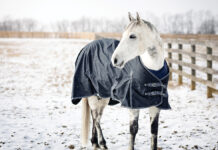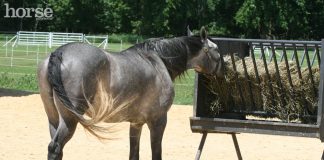Internal parasites (“worms”) cause problems for horses of all ages. These freeloaders compromise a horse’s health both directly and indirectly. They’re particularly well-adapted to survive in the horse and in the environment, so controlling them is a constant battle for horse owners.
Many different types of internal parasites attack horses, but the most important are the large strongyles, small strongyles, roundworms and tapeworms.
Large strongyles (Strongylus vulgaris, Strongylus edentatus and Strongylus equinus). Horses become infected with large strongyles by ingesting the larvae, which have hatched from eggs passed in the manure of an infected horse. Once inside the digestive tract, the larvae penetrate through the intestinal wall and migrate throughout the body. Strongylus vulgaris larvae migrate in the cranial mesenteric artery, causing inflammation and clots that can disrupt the intestinal blood supply and cause colic. After migrating, the larvae wind up in the large intestine, where they mature and produce eggs. The entire cycle takes about 6 to 11 months.
Small strongyles (cyathostomes). These pests often occur with large strongyles. Infection occurs in a similar manner. Small strongyles don’t migrate outside of the intestine, but develop within the intestinal wall. Some larvae become dormant, emerging after months to resume development in the intestine. Most adult small strongyles attach to the intestinal lining to feed. Light infections cause little damage, but heavy infections can inhibit nutrient absorption and cause digestive problems. One type of small strongyle can cause extensive ulceration of the colon.
Roundworms (Parascaris spp.). These large (up to 12 inches long) worms are mainly a problem for foals, which become infected when they ingest the eggs, which can survive for years in contaminated soil. In the digestive tract, the eggs release the larvae, which migrate through the body. They eventually reach the lungs, where they are coughed up and swallowed. After returning to the digestive tract, the larvae mature into adults. In addition to coughing, roundworm infection can cause poor condition, stunted growth, rough hair coat and a pot-bellied appearance. A heavy parasite load can lead to impaction colic, especially in foals being dewormed for the first time.
Tapeworms (Anoplocephala magna, A. perfoliata and Paranoplocephala mamillana). These large (3-10 inches long) parasites live in the small intestine, cecum, stomach and other parts of the digestive tract. Equine tapeworms require an intermediate host—the forage mite—to be infective. The mite eats the larvae, which develop within the digestive tract. The horse then ingests the mite while eating hay, grass or grain and the larvae enter the horse’s digestive tract, where they develop into adults. Light tapeworm infections may be asymptomatic, but heavy infections can cause ulceration, abscessation or perforation of the intestinal wall. A recent research study showed that tapeworms were associated with up to 22 percent of the cases of spasmodic (gas) colic and almost 80 percent of the cases of colic due to ileocecal impaction.
Click here to see a chart of the life cycle of equine parasites.
Diagnosis
Most internal parasites can’t be seen by the naked eye. The clinical signs may be equally obscure, at least until a major problem occurs. Your veterinarian can make a diagnosis by using a fecal flotation test to find the eggs in a fecal sample. Another test, called a fecal egg count (FEC), is used to quantitate the number of eggs per gram of feces, which indicates the severity of the infection. It’s also used for fecal egg count reduction testing (FCRT), a procedure that monitors treatment success.
Dewormers
Most equine dewormers belong to three classes of compounds: the macrocyclic lactones (ivermectin, moxidectin), the benzimidazoles (fenbendazole, oxibendazole) and the tetrahydropyrimidines (pyrantel). Most are effective against several different parasites. Ivermectin and moxidectin are effective against migrating and dormant larvae as well as adults. Praziquantel, another type of compound, is used to treat tapeworm infections.
Years ago, the most effective method for deworming a horse involved giving the medication via stomach tube, a procedure that had to be performed by a veterinarian. The introduction of paste dewormers, which can be administered directly into the horse’s mouth, has allowed most owners to take care of deworming by themselves. Some medications are also available as granules or liquid that can be sprinkled on the feed.
Before using any dewormer, make sure that it’s effective for your horse’s parasites and that you understand how to use it correctly (read the label). Ask your veterinarian if you have any questions.
Deworming Programs
It was once thought that regular deworming—for example, every two months—was the best approach to parasite control in horses. Some owners opted to use products that could be administered daily in the feed. Rather than controlling the parasites, these practices have had just the opposite effect: the worms have become resistant to many commonly used dewormers. For example, benzimidazoles are no longer effective against many types of small strongyles. While resistance to ivermectin and moxdectin has not yet occurred, experts fear that it will, since these compounds are so widely used.
When planning a deworming program, use the following strategies to reduce the development of resistance:
- Discontinue lock-step deworming schedules.
- Use an FEC to determine if your horse actually needs to be dewormed. If he only needs it once or twice a year, there’s no need to treat him more frequently.
- When deworming is needed, rotate the products you use, so you’re not using the same class of compound every time.
- Use FECRT two weeks after deworming to determine if the treatment was successful (90 percent reduction: successful; 80 percent reduction: marginal; less than 80 percent: unsuccessful). If the treatment failed, you’ll need to re-treat with a different class of dewormer.
Click here to see all materials for this course






Good insight on the programs part!
very comprehensive – learned a lot
Good refresher. Nice to know the stuff I learned 20 years ago is still true.
Great info!
great info
Very informative!
Interesting I never knew horses could get resistant to some types of dewormer!
Very good to know!